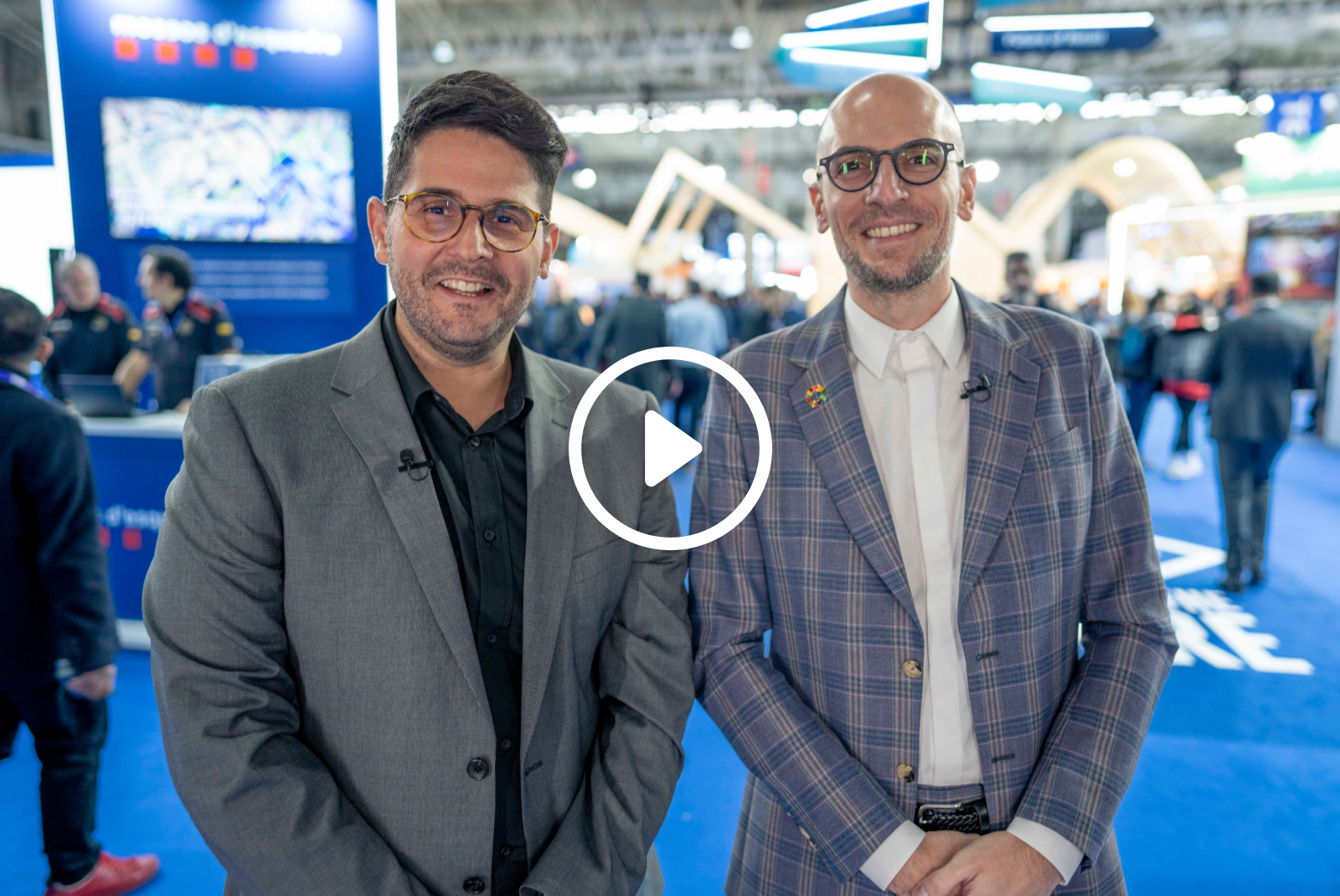Tell us more about your participation in Cabsat 2023? How was the event for you this year?
The event was very successful for the ST Engineering iDirect team. Our booth was constantly busy and we had a lot to show our visitors this year including demos on IoT, virtualization and the DIFI standard. We also showcased our Starlight 100 Manpack antenna. The Middle East and Africa regions are dynamic and critical to our business, so it was fantastic to see so many of our partners, customers and friends during the event.
As a finalist for the WTA Tech of the Year award in 2023, what makes your IoT solutions robust, cost-effective, and highly scalable?
Our IoT solution has really gained momentum in the market since its launch. We offer an integrated, optimized, end-to- end IoT solution that is integrated into the existing operator’s hub infrastructure. This reduces the costs and complexities associated with launching an IoT service.

Our IoT solutions are built to withstand a range of environments yet are compact in size and lightweight. Our solutions are built on ST Engineering iDirect’s scalable Evolution®, Velocity® and Dialog® satellite hub infrastructures. The IoT solutions incorporate an IoT-optimized waveform to support fixed or mobile IoT applications in a wide range of markets including fleet management, energy, mining, utilities, fishing, agriculture and critical infrastructure.
How is ST Engineering iDirect leading the digital transformation of teleports and contributing to the evolution of the satellite industry?
At ST Engineering iDirect, we are deeply engaged with enabling digital transformation, which will eventually allow the satellite to become an integral part of the telco ecosystem. To achieve this, certain things will need to happen. The first is a move towards Open Standards. This will be a critical part of ground segment evolution. Converting hardware into software that is installed and managed remotely via third-party data centers will give network operators more flexibility over their networks and speed up how quickly they can respond to customer demands.
The first step for us was to work towards modem virtualization. In September 2022, together with Microsoft Azure, we successfully demonstrated an important milestone: the ability of a virtual modem to extract information from a high-speed satellite connectivity link. Our demonstration showcased a virtualized SCPC modem receiving satellite signals digitally via an ethernet cable. Signals from satellites today are traditionally connected to physical modems via analog cables that are not directly compatible with cloud-based networks.

This demonstration showed that, in the future, it’s possible for virtual modems to run on third-party cloud infrastructure replacing the need for a physical on-premise satellite modem. It’s proof that future satellite connectivity can be established from a cloud environment through the digital interface directly to the antennas.
Then, earlier this year and again at CABSAT, we demonstrated a successful proof of concept (PoC) of converting analog signals to digital signals utilizing the Digital Intermediate Frequency Interoperability (DIFI) 1.1 Standard, developed by the DIFI consortium.
At ST Engineering iDirect, we are deeply engaged with enabling the digital transformation, which will eventually allow satellite to become an integral part of the telco ecosystem. To achieve this, certain things will need to happen. The first is a move towards Open Standards. This will be a critical part of ground segment evolution.
TAJANI BOUQENTAR
VP SALES & GM MIDDLE EAST
The standard provides a path to enable the digital transformation of the space industry by providing interoperability at the IF/RF layer. The standard will enable all manufacturers to build interoperable technologies that work in both open and closed network topologies, resulting in highly flexible networks and enabling the industry to respond rapidly to customer demands.
These are both great milestones, but there are also many other aspects to interoperability. The integration of satellite networks
with terrestrial networks, for instance, requires interoperability at the management and orchestration layer. Here, the standardization work being done within 3GPP looks very promising. Another area is space and ground convergence, which requires tighter interaction between the satellite and ground assets. Again, standardization on how these different components should interface is currently being examined.
However, in order to fully virtualize the ground segment and to create a digital teleport, the next area of development will need to look at how modulators and demodulators interface with other key parts of the teleport such as antennas, amplifiers and frequency converters. All parts of the ecosystem will need to be engaged to complete the puzzle.
The entire ecosystem must be on board to make the virtualization of the ground segment a success. Different industry segments will need to work together to implement the standard: cloud providers, satellite ground platform manufacturers, teleport operators, antenna manufacturers, and ground segment ODU manufacturers (antenna, BUC/ amplifiers and frequency converter manufacturers).
If we only cloudify the modem side, then the antennas or amplifiers won’t be able to speak the digital language, and this will mean that we cannot create a fully digital teleport. The satcoms industry must continue to work to standardize interfaces and increase their adoption.
Can you provide more details about the SKYFlow ecosystem and its capability to extend the reach of OTT providers and telcos?
Congested networks and geographical reach of terrestrial systems have often been a stumbling block for OTT providers and telcos. As they try to attract new subscribers in more remote regions of the world, they must be able to extend their reach beyond the realms of terrestrial networks.
SKYflow is a multi-award-winning ecosystem that has the potential to be a true broadcasting game-changer.
Developed with our partners: Broadpeak, Quadrille, Easy Broadcast and EKT, SKYflow enables users to solve the challenges faced by OTT providers and Telcos due to its capability to reach anywhere in the world, transporting high bitrates to the edge, its multicasting performance and smart pre-positioning of content at the edge.
The important thing to note about SKYflow is the breadth of markets that it can address. These include remote education, remote hotspots, network offload, and aeronautical, and maritime use cases.
In order to fully virtualize the ground segment and to create a digital teleport, the next area of development will need to look at how modulators and demodulators interface with other key parts of the teleport such as antennas, amplifiers and frequency converters. All parts of the ecosystem will need to be engaged to complete the puzzle.
TAJANI BOUQENTAR
VP SALES & GM MIDDLE EAST
This illustrates how that massive outreach can go straight to billions of connected devices in people’s hands, meaning that network boundaries will be pushed further than ever before to enable new types of applications and services across almost every industry. All this market growth is only set to increase – and of course, traditional barriers to content options no longer apply.
The Peruvian government has contracted ST Engineering iDirect and our local integrator, DIVICAM to deploy the SKYflow ecosystem solution to deliver OTT video and documents to remote regions of Peru, enabling the Peruvian people to access public content including educational content that has previously been unavailable to them.
Can you elaborate on the initiatives and collaborations that ST Engineering iDirect has been involved in to ensure the satellite’s role in 5G is secured?
This is far bigger than any one company and will take dedication and participation between the satellite industry, Telco entities and terrestrial standards organizations such as MEF and 3GPP to make it happen. Securing a place at the table with these groups is essential to drive home the importance of satellites in 5G networks.
Over the last few years, several consortia have formed with the aim to validate satellite integration into a 5G core network such as Sat5G, Satis5, Osmosis and iNGENIOUS. ST Engineering iDirect has been working with these consortia and participating directly in the 3GPP standards initiative ensuring that, as our industry adopts the standards defined by 5G, it is optimized for satellite communications.

At CABSAT, we showcased one such example which was recently demonstrated as part of the H2020 iNGENIOUS project where industry partners came together to demonstrate how IoT sensor data was being tracked from a shipping container on land and at sea over a 5G-enabled satellite system. In the demonstration the ST Engineering iDirect satellite system provided the satellite backhaul connectivity for the IoT devices to connect to the cloud via a satellite modem that behaved like a 5G UE to an integrated 5G core network.
How do you envision satellite 5G being an indispensable part of the future, enabling connectivity where other access technologies cannot reach?
Satellite is going to be integral to the delivery of ubiquitous 5G services. Terrestrial connectivity can only reach so far, yet 5G needs to be accessible everywhere. Therefore, satellite will be the critical technology that extends 5G services way beyond terrestrial connectivity’s reach, on land, sea and air, through multi-orbit constellations.
Eventually, the network will deliver a seamless 5G experience so that users are always connected by the most suitable access technology at the right time. Satellite will be integral to this portfolio of technologies.
Satellite is going to be integral to the delivery of ubiquitous 5G services. Terrestrial connectivity can only reach so far, yet 5G needs to be accessible everywhere. Therefore, satellite will be the critical technology that extends 5G services way beyond terrestrial connectivity’s reach, on land, sea and air, through multi-orbit constellations.
TAJANI BOUQENTAR
VP SALES & GM MIDDLE EAST
How do you envision the future growth and expansion of ST Engineering iDirect’s solutions and technologies in the satellite communications industry?
In 2021, we introduced our New Ground initiative, which aims to prepare the satellite ground segment for the changes that we see happening in terms of New Space capabilities and the wider network of networks. We need to prepare for this convergence. All of the innovation that is happening to make this reality is what we refer to as New Ground.
At ST Engineering iDirect, we will continue to work towards this goal of convergence and interoperability and will foster a collaborative approach with our fellow industry innovators.
In parallel, we will continue to do what is embedded in our DNA. We will continue to deliver the very highest standard of performance and reliability to our partners and customers so that they can continue to thrive, grow and pursue every opportunity across every market, whether that is established or emerging.












